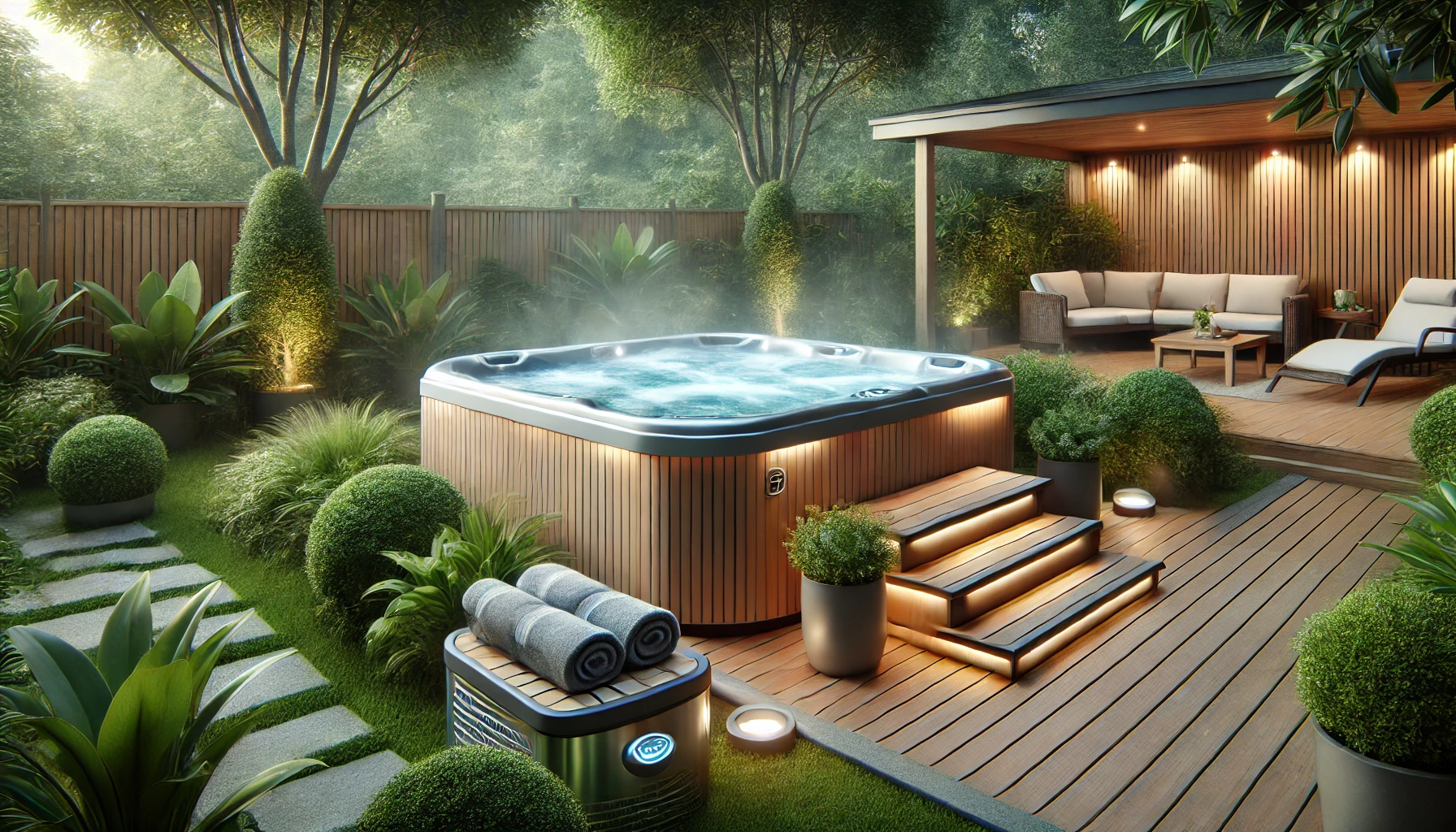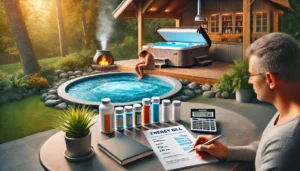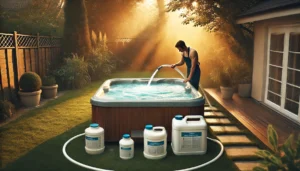Did you know that hot tub-related injuries send about 6,600 people to the emergency room each year?
I certainly didn’t when I first decided to install my own backyard oasis.
As a proud hot tub owner (and occasional klutz), I’ve learned the hard way that understanding how these bubbly havens of relaxation fit into your homeowners insurance is crucial.
Trust me, you don’t want to be caught off guard when things go sideways – or should I say, when someone goes splashing!
In this comprehensive guide, I’m going to walk you through everything you need to know about hot tubs and homeowners insurance.
We’ll dive deep into coverage options, safety requirements (because nobody wants to be that neighbor), maintenance tips that’ll make your insurance company smile, and the legal stuff that’ll keep you out of hot water.
So grab a towel, and let’s jump in!
Are Hot Tubs Covered By Homeowner’s Insurance?
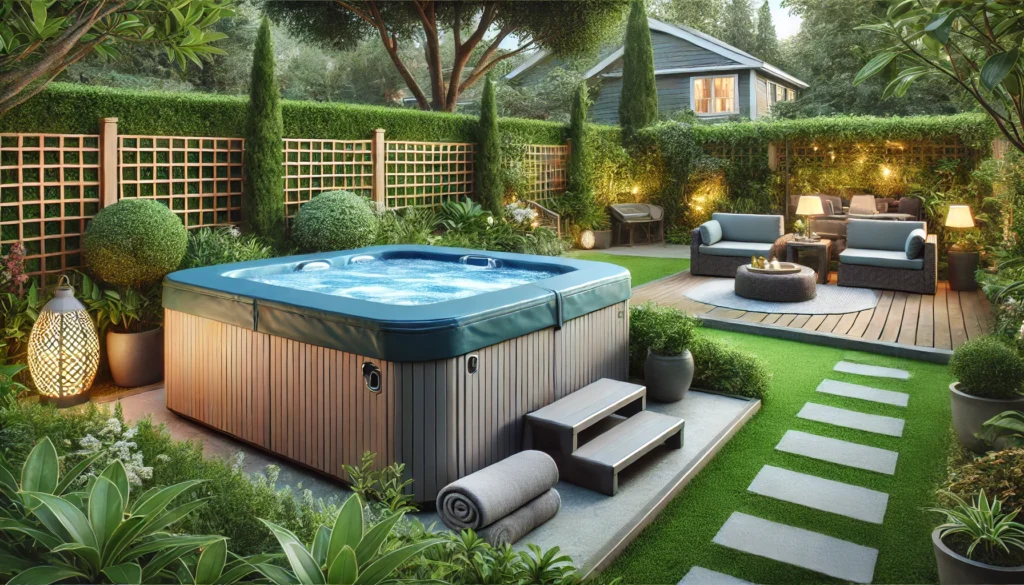
Hot tubs are typically covered by standard homeowner’s insurance policies, but the extent of coverage is often limited.
Most policies include hot tubs under dwelling or other structures coverage for property damage, and under personal liability coverage for accidents.
However, coverage limits may be insufficient for high-end models or serious accidents, and policies often have exclusions for damage due to poor maintenance or freezing.
Many homeowners find they need additional endorsements or riders specifically for their hot tub to ensure adequate protection.
Now, let’s dive deeper into the intricacies of hot tub coverage, exploring the nuances that every hot tub owner should know to stay properly protected.
Understanding Hot Tub Coverage in Homeowners Insurance
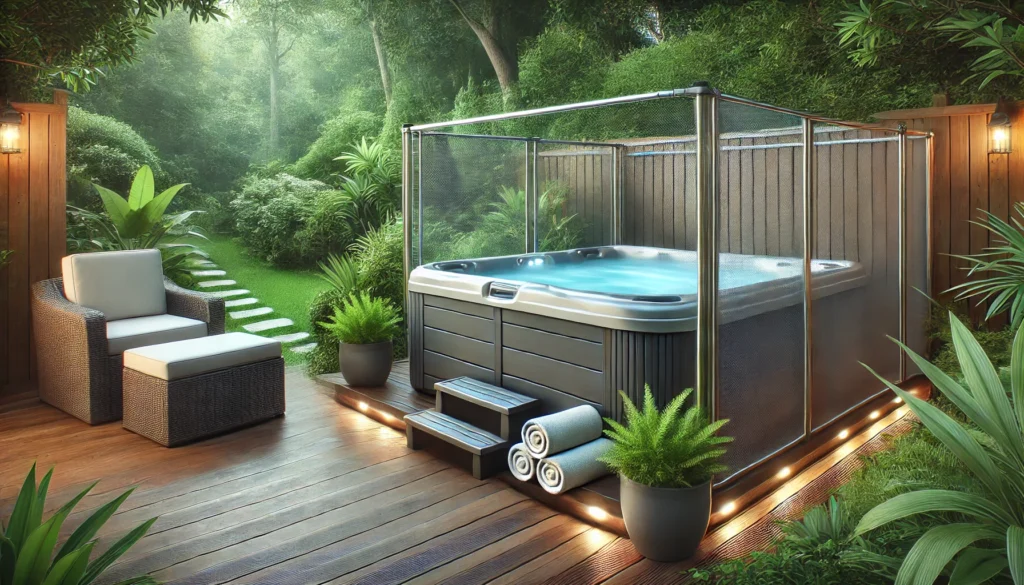
When I first got my hot tub, I assumed my regular ol’ homeowners policy had me covered. Boy, was I in for a surprise!
Here’s the deal: most standard policies will cover the structure of your hot tub under the “other structures” portion of your policy. But – and this is a big but – the coverage is often limited.
Let’s break it down. Property damage coverage typically covers damage to the hot tub itself, like if a tree branch decides to take a dip during a storm.
It might also cover things like vandalism or theft of hot tub components. But here’s where it gets tricky – many policies have exclusions or limitations when it comes to hot tubs.
Then there’s liability coverage. This is the big one, folks. It protects you if someone gets injured in or around your hot tub.
Think slip-and-fall accidents, drowning risks, or even those bizarre “I didn’t know the water would be hot!” claims. But again, standard coverage might not be enough.
I learned this the hard way when my neighbor’s kid decided to practice his cannonballs in my hot tub while we were away.
Let’s just say the resulting damage wasn’t fully covered, and I had to shell out some serious cash. Don’t make my mistake!
So, what’s a responsible hot tub owner to do? Add specific hot tub coverage to your existing policy!
You might need additional property coverage to fully protect your hot tub investment. Given the higher risks associated with hot tubs, you might want to increase your liability limits too.
Some policies offer medical payments coverage, which can help cover minor injuries to guests without them filing a liability claim.
And for those who want extra peace of mind, an umbrella policy provides additional liability coverage beyond your standard homeowners policy limits.
When you’re looking to add hot tub coverage, keep a few factors in mind. The value of your hot tub matters – a high-end model with all the bells and whistles will likely need more coverage than a basic portable spa.
Its location is important too. Indoor hot tubs might be seen as lower risk, but they also come with potential water damage concerns for your home. Safety features you have in place, like locked covers, fencing, and non-slip surfaces, can sometimes lower your premiums.
How often you use it matters as well – a hot tub that’s used daily might be seen as higher risk than one that’s only fired up occasionally. And of course, your claims history plays a role. If you’ve had previous hot tub-related claims, your premiums might be higher.
Your premium might go up a bit when you add hot tub coverage, but trust me, it’s worth it for the peace of mind. And who knows? If you play your cards right with safety features and maintenance, you might even snag a discount!
So, you’re convinced you need extra coverage. Great! Here’s how to go about it. First, contact your insurance provider. Give them a call and let them know you’ve added a hot tub to your property.
Review your current policy with your agent to identify any gaps in coverage. Discuss the specific hot tub endorsements or riders they offer.
If your current provider’s options seem limited or expensive, don’t be afraid to shop around and get quotes from other insurers.
Once you’ve decided on the right coverage, make sure to get everything in writing.
Remember, it’s always better to have this conversation with your insurance company before you need to make a claim. Trust me, future you will thank present you for being proactive!
Safety First: Mitigating Risks and Reducing Insurance Costs

Let’s talk safety, people! Not only will these tips keep your insurance company happy, but they’ll also help prevent those “hold my beer and watch this” moments that end up on YouTube.
First things first – fencing. When I installed my hot tub, I thought the cover was enough. Nope!
My insurance agent (let’s call her Debbie Downer) informed me that I needed a fence. And not just any fence – we’re talking at least 4 feet high with a self-latching gate.
It was a pain to install, but it’s kept the neighborhood kids (and tipsy adults) from unsupervised soaking.
Most insurance companies (and local codes) require at least 4 feet, but 5 or 6 feet is even better.
The material should be climb-resistant. No horizontal bars that double as a ladder for adventurous toddlers!
You’ll want self-closing and self-latching gates, and consider a lock for extra security. The fence should completely enclose the hot tub area, with no easy ways to climb over or under.
Next up, covers. Get a good one, and actually use it! I can’t tell you how many times I’ve been tempted to leave the cover off “just for tonight.”
But a sturdy, lockable cover is your first line of defense against accidents and insurance claims.
When shopping for a hot tub cover, look for good insulation. A well-insulated cover not only saves on energy bills but also provides better structural integrity. Child-resistant locks are crucial.
Some even come with keys for extra security. Make sure it can support the weight of a child or pet without caving in.
And don’t forget about weather resistance – look for UV-resistant and waterproof materials to extend the life of your cover.
Here’s a pro tip: Consider a cover lifter. It makes removing and replacing the cover a breeze, which means you’re more likely to actually use it consistently.
Now, let’s talk about the less obvious stuff. Non-slip surfaces are crucial. I learned this one the hard way after doing my best Bambi-on-ice impression getting out of the tub.
A few non-slip mats later, and I’m much less likely to star in my own personal slapstick comedy.
If you’re installing a new deck around your hot tub, opt for textured materials. You can also place non-slip mats around the perimeter of your hot tub.
Just make sure to clean them regularly to prevent mold growth. For existing smooth surfaces, you can apply non-slip coatings to add traction. And if your hot tub has built-in steps, make sure they have non-slip treads.
Lighting is another important safety feature. Midnight soaks are great, but not if you can’t see where you’re going. I installed some motion-sensor lights, and voila – no more stubbed toes!
Illuminate the path to your hot tub to prevent trips and falls. Soft lighting around the hot tub area can enhance the mood while providing necessary visibility.
Many modern hot tubs come with built-in lighting – use it! And consider a backup light source in case of power outages.
Let’s not forget about water safety. Keep those pH levels in check, folks. Not only will it prevent some nasty infections, but it’ll also keep your insurance company off your back about maintenance.
Invest in a good testing kit and use it at least twice a week. Keep your chemicals locked away and out of reach of children and pets.
Encourage everyone to rinse off before entering the hot tub. It helps maintain water quality and reduces the need for chemicals.
And be aware of health conditions that might be exacerbated by hot tub use, like pregnancy or heart problems.
I’ve got a little sign posted with the basic rules – no diving, no glass containers, no unsupervised children.
It’s not the prettiest decoration, but it could save you a world of trouble.
Consider including rules like no alcohol consumption in or around the hot tub, maximum occupancy limit, no electrical devices near the water, and emergency shut-off instructions.
Temperature control is often overlooked, but it’s crucial. Keep your hot tub temperature at or below 104°F (40°C).
Higher temperatures can lead to heat-related illnesses and increase liability risks. Use a reliable thermometer to double-check the built-in temperature gauge.
Adjust the temperature lower for children or pregnant women. Encourage breaks every 15-20 minutes to prevent overheating.
And never use the hot tub alone, especially if you have health conditions or are taking medications that might be affected by heat.
Remember, the safer your hot tub area, the lower your insurance risk. And lower risk often means lower premiums. Win-win!
Hot Tub Installation: Insurance and Home Value Considerations
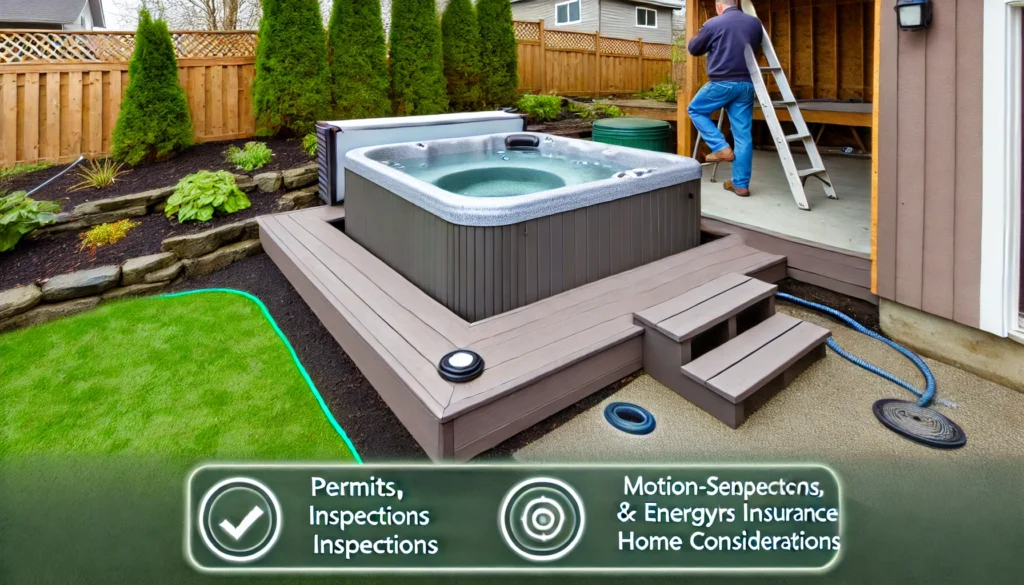
Alright, let’s talk installation. When I decided to take the plunge (pun absolutely intended) and get a hot tub, I had no idea it would turn into a whole thing with my insurance.
First up, you’ve got to decide: permanent or portable? I went permanent because, well, go big or go home, right?
But here’s what I didn’t know – permanent hot tubs are usually covered under the dwelling portion of your homeowners insurance, while portable ones might fall under personal property.
This can affect your coverage limits and deductibles.
Permanent hot tubs have their pros and cons. They’re often seen as part of the home’s structure, potentially increasing home value.
But they also require more complex installation and usually require professional help. Portable hot tubs, on the other hand, are easier to install and move, and potentially have a lower initial cost. But they might have lower coverage limits and could be seen as less valuable by insurers.
Now, let’s chat about how this bubbly addition affects your home’s value. I was pumped, thinking my hot tub would send my property value soaring.
Reality check – it might, but not always. Some appraisers see it as a luxury feature, while others consider it a maintenance liability.
Several factors influence how a hot tub affects your home value. The quality and condition of the hot tub matter, as does how well it’s integrated into the landscape or home design.
Local climate plays a role too – hot tubs tend to be more valuable in colder regions. And of course, current real estate trends in your area will have an impact.
My advice? Don’t install a hot tub just for the resale value. Do it because you want to live your best, pruney-fingered life.
Here’s where it gets fun (and by fun, I mean bureaucratic): permits and inspections. Oh boy, did I learn about these the hard way.
Turns out, you can’t just plop a hot tub wherever you want. You need permits, and you need to pass inspections. Electrical, structural, the works. It’s a pain, but it’s necessary.
Why are permits and inspections so important? First, it’s about legal compliance. You want to avoid fines and legal issues down the road.
It’s also about safety – ensuring your installation meets all safety standards. From an insurance standpoint, if you skip this step and something goes wrong, your insurance might just tell you to take a hike.
And if you ever decide to sell your home, proper documentation can be a selling point.
You might need several types of inspections. Electrical inspections ensure proper grounding and GFCI protection.
If you’re putting the hot tub on a deck or patio, you’ll need a structural inspection. Permanent installations connected to your home’s water supply require plumbing inspections.
And don’t forget about zoning inspections to make sure your hot tub complies with local ordinances.
Here’s a pro tip: Work with a licensed contractor who’s familiar with local codes. They can often handle the permit process for you, saving you a lot of headaches.
If you’re going the energy-efficient route (and you should – your utility bill will thank you), ask your insurance provider about discounts.
Some companies offer lower rates for energy-efficient hot tubs because they’re seen as lower risk. Who knew being green could save you some green?
When shopping for an energy-efficient hot tub, look for high-quality insulation in the shell and cover, energy-efficient pumps and heaters, LED lighting, and smart controls for optimized energy use.
Remember, an energy-efficient hot tub isn’t just good for your wallet – it’s good for the planet too!
Where you put your hot tub matters, both for your enjoyment and your insurance. You probably don’t want to be on display for the whole neighborhood, so consider privacy.
Make sure it’s easy to get to, but not so easy that it becomes an attractive nuisance. Think about proximity to the house – closer can be more convenient but might increase water damage risk to your home.
If you have a nice view, position your hot tub to take advantage of it. And don’t forget about wind protection – a sheltered location can help with heat retention and comfort.
Here’s an insurance tip: Some policies might have different coverage limits or requirements based on whether your hot tub is indoors, on a deck, or freestanding in your yard. Always check with your insurer!
Maintaining Your Hot Tub: Insurance Requirements and Best Practices

Alright, confession time. When I first got my hot tub, I thought maintenance meant occasionally fishing out leaves and topping off the water. Oh, how wrong I was.
Let’s start with the maintenance log. Yes, you need one. No, a mental note doesn’t count (trust me, I tried that excuse).
Your insurance company might ask to see this log if you ever need to make a claim. I keep mine in a waterproof folder right next to the hot tub. It’s not fancy – just a notebook where I jot down what I’ve done and when.
In your maintenance log, you should include water testing results and chemical adjustments, filter cleanings and replacements, equipment checks and repairs, professional service visits, and any unusual events like power outages or extreme weather.
Here’s a pro tip: Take photos of any repairs or upgrades. A picture is worth a thousand words, especially when you’re filing an insurance claim!
Now, the big question: DIY or call in the pros? I started off doing everything myself because, hey, how hard could it be?
Turns out, pretty hard. After a few mishaps (let’s not talk about the Great Foam Incident of 2019), I now have a professional come in for the big stuff.
There are some things you can probably handle yourself.
Regular water testing and chemical balancing, cleaning the filters, wiping down the shell and cover, and basic troubleshooting (like resetting a tripped GFCI) are all manageable for most people.
But there are times when you should definitely call in the pros. Annual equipment check-ups, replacing major components like pumps or heaters, diagnosing complex issues, and winterizing (if you’re not comfortable doing it yourself) are best left to the experts.
Most insurance companies prefer professional maintenance because it reduces the risk of damage due to improper care.
Plus, having records of professional service can be a big help if you ever need to make a claim.
Speaking of winterizing, this is crucial if you live somewhere that gets cold. I learned this the expensive way when I didn’t properly drain my pipes one winter. The repair bill was… not fun.
Now, I either keep my hot tub running all winter (with the proper precautions) or have it professionally winterized.
If you’re keeping your hot tub running in winter, maintain a consistent water level to prevent freezing.
Check the cover for snow accumulation regularly. Invest in a good floating thermal blanket for extra insulation. And consider a backup power source in case of outages.
If you’re shutting it down for the winter, you’ll need to drain all water from the tub, pipes, and equipment.
Blow out the lines with a wet/dry vacuum or air compressor. Remove and clean the filters. Clean and dry the shell thoroughly. And secure the cover with locks or wind straps.
Remember, improper winterizing can lead to costly damage that might not be covered by your insurance. When in doubt, hire a pro!
Now, let’s talk about some common issues that could void your insurance. Ignoring leaks, even small ones, is a big no-no. A tiny drip can turn into a big problem fast. Not only can it lead to water damage, but it can also be a sign of more serious issues.
Using the wrong chemicals is another problem. This can damage your hot tub’s components and create health hazards. Always follow the manufacturer’s recommendations.
Skipping regular cleaning is asking for trouble. A dirty hot tub is a breeding ground for bacteria and can lead to equipment failure.
Failing to maintain proper water levels is also risky. Low water can cause pump burnout, while overfilling can lead to electrical issues.
Don’t neglect your cover. A damaged cover can lead to energy waste, water contamination, and safety hazards.
And unless you’re qualified, leave the complex repairs to the professionals. DIY repairs gone wrong can void your warranty and your insurance coverage.
Lastly, document everything. And I mean everything. That time you replaced the pump? Write it down. Updated the cover? Note it.
Conclusion
Phew! We’ve covered a lot of ground, haven’t we?
From understanding insurance coverage to safety measures, maintenance musts, legal considerations, health aspects, and even environmental concerns – owning a hot tub is more complex than I ever imagined when I first took the plunge.
Let’s recap the key points:
- Review your insurance policy regularly to ensure you have adequate coverage for your hot tub.
- Implement safety measures like fencing, covers, and non-slip surfaces.
- Stay on top of maintenance and keep detailed records.
- Be aware of your liability as a hot tub owner and take steps to protect yourself.
- Understand and mitigate health risks associated with hot tub use.
- Consider the environmental impact and look for ways to operate your hot tub efficiently.
Remember, while all this might seem overwhelming, it’s all in service of ensuring you can enjoy your hot tub worry-free.
Trust me, there’s nothing quite like sinking into those warm, bubbly waters after a long day, knowing you’re fully covered (insurance-wise, that is – don’t forget your swim trunks!).
I encourage you to take this information and customize it to your specific situation. Every hot tub, every home, and every owner is unique.
And please, always prioritize safety – for yourself, your family, and your guests.
Owning a hot tub can be a wonderful experience. It’s a place to relax, to socialize, to ease aching muscles, and to create lasting memories.
But like any luxury, it comes with responsibilities. By staying informed and proactive, you can minimize the risks and maximize the enjoyment.
Now, I’d love to hear from you! Do you have any hot tub insurance stories or tips to share? Any maintenance hacks that have saved you time or money?
Maybe you’ve found a particularly effective way to keep the neighborhood squirrels from using your cover as a dance floor?
Drop your thoughts in the comments below. After all, we’re all in this bubbling community together!
Stay safe, stay covered, and happy soaking!
